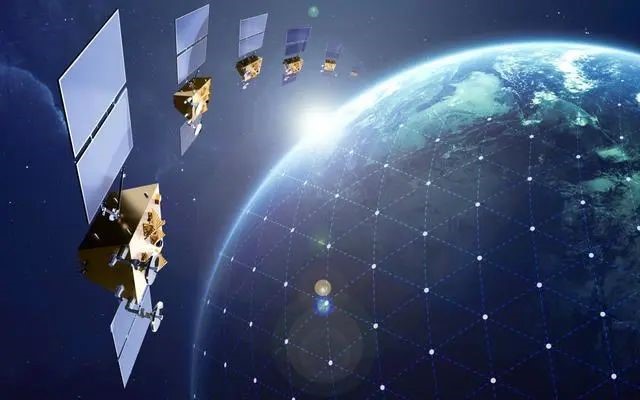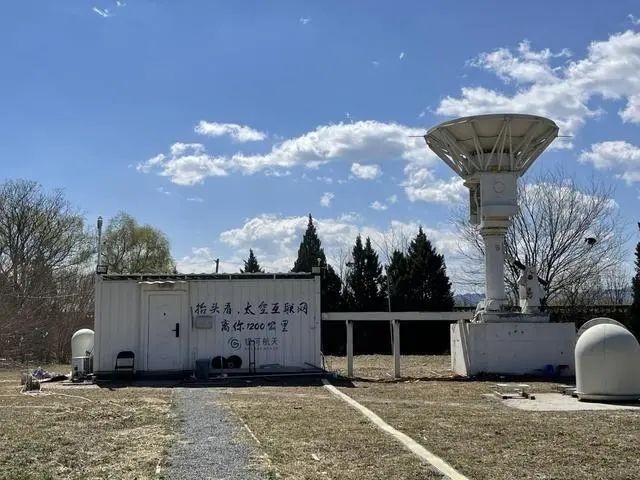GalaxySpace successfully realized the first domestic V-band low-orbit satellite measurement and control on its 02 batches of satellites. This batch of satellites was successfully launched at the Xichang Satellite Launch Center on March 5. It is the first low-orbit broadband communication satellite developed in batches in my country.
In-orbit simulation map of Galaxy Aerospace 02 batches of satellites
What is V-band satellite measurement and control?
“Usually, it refers to the use of V-band radio waves to realize the tracking, measurement and remote control of satellites, to obtain information such as the position and status of the satellites, and to control various platforms and loads of the satellites.” said Zhu Zhengxian, CTO of GalaxySpace to Beijing News reporter.
For a long time, satellite communications usually use Ku/Ka frequency band resources, and these frequency band resources have gradually become saturated. With the increasing difficulty of frequency coordination and the substantial increase in the demand for communication capacity and bandwidth, international commercial communication satellites are gradually developing to higher frequency bands.
Zhu Zhengxian said that at this situation, GalaxySpace used the technically difficult Q/V frequency bands in many of its self-developed low-orbit broadband communication satellites.
These frequency bands are the most suitable for satellite communication services in the
millimeter wave frequency band. It has the advantages of large bandwidth, large capacity, narrow beam and low cost, and is still in the initial stage of development internationally.
The successful realization of V-band satellite measurement and control brings positive significance for China’s satellite Internet to achieve corner overtaking.
“V-band satellite measurement and control technology are very important for the development of broadband communication satellites.
Especially for the low-orbit communication satellite constellation for large-scale networking in the future, it is not only a substantial increase in the number of satellites in orbit on the operation, but also the cooperative working mode of the constellation turns to be the routine of satellites working status.
How to achieve efficient satellite measurement and control? It is an urgent problem to be solved.” Zhu Zhengxian said.
Compared with the traditional commercial satellite X measurement and control, the V measurement and control can reuse the radio frequency channel of the ground gateway station by using the service frequency, and transmit it with the feeder side business, reduce the dependence on the commercial measurement and control station, and save the ground resources and costs.
The V-band measurement and control frequency is high, the available bandwidth is large, so it can support higher remote control information rate and telemetry information rate. Through the V measurement and control of the current transit satellites, the satellite telemetry monitoring and remote control of the entire constellation can be realized.
At the same time, taking advantage of the high-speed uplink and downlink rate of V measurement and control, as the high-speed data transmission and high-speed upload channel of the integrated communication and remote sensing satellite, it can improve the level of satellite integration and save satellite equipment resources.
GalaxySpace Beijing Xinguan Station. Photo courtesy of GalaxySpace
The traditional satellite measurement and control station and the satellite communication gateway station cannot be integrated. To realize the satellite measurement and control and communication, it is necessary to build the measurement and control station and the gateway station respectively.
This time, GalaxySpace took the lead in adding satellite measurement and control functions on the side of the Xinguan station, multiplexing the V antenna and channel of this gateway station, and using the V measurement and control telemetry spread spectrum signal as the ground antenna to track the beacon, carrying out communication services and satellite monitoring and control during satellite transit. By which, the V measurement and control business is ideally integrated with the feeder business
However, Zhu Zhengxian also mentioned that it is not easy to realize the measurement and control of the V-band, and it is necessary to overcome the problems of large Doppler frequency shift under the high dynamics of the V-band, narrow ground antenna beam, and high tracking accuracy requirements. Overcoming the above problems requires self-developed core hardware equipment. One of the most difficult components is the measurement and control transponder.
“The on-board transponder is a key component of satellite measurement and control. Its main function is to provide a reliable wireless communication link between the satellite and the ground for remote control command reception, telemetry information forwarding, and measurement frame transmission and reception.
Generally speaking, if a satellite is compared to Kite, then the transponder is the line that controls the kite, which can realize satellite control through the measurement and control wireless link, and is an indispensable accessory device for each satellite.” Zhu Zhengxian said.
According to reports, GalaxySpace took 10months to develop the V/X band multi-mode measurement and control transponder carried by the 02 batches of satellites.
From antennas, radio frequency to hardware products of digital full signal chain, as well as the digital signal processing and other software are all developed by GalaxySpace independently.
Through software radio, multi-chip components, high-efficiency power components and other technologies, the technical team has achieved great optimization in terms of weight, power consumption, size and function.
Frequency band reference
(Source: Chinese Science Journal)





